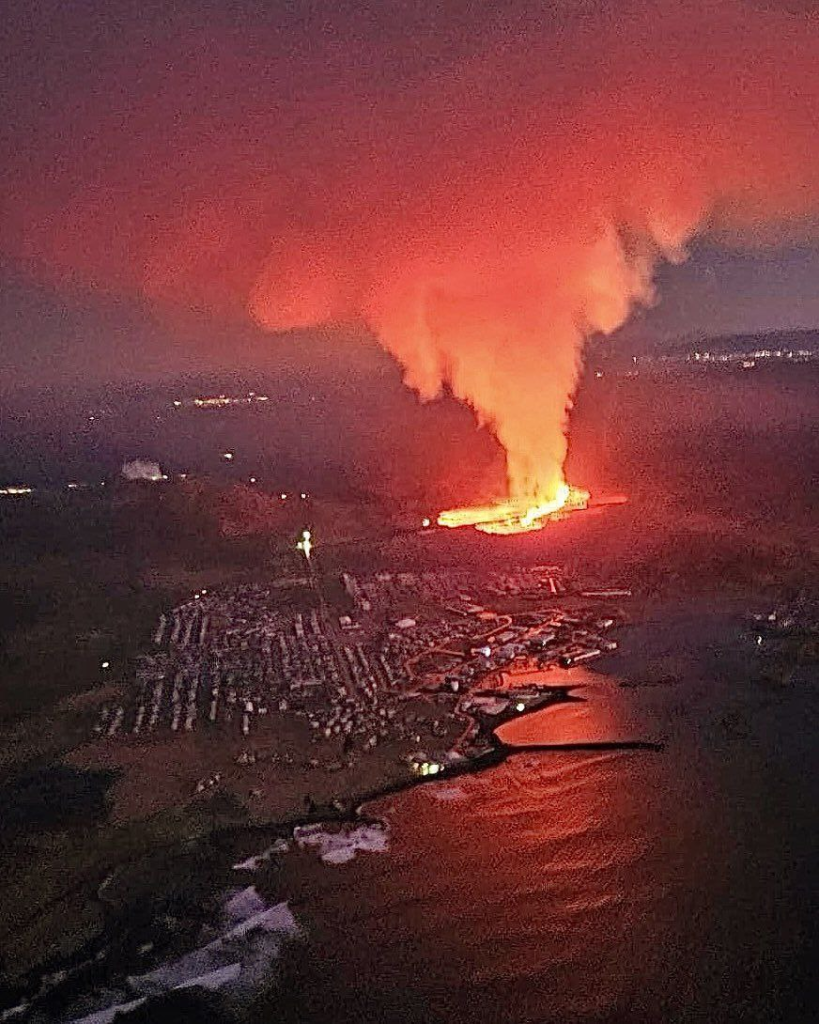Early on Sunday, a volcano in southwest Iceland erupted, sending a cascade of lava toward the town of Grindavik. Preceded by hundreds of earthquakes, this event forced the overnight evacuation of residents and came less than a month after a powerful eruption in the same region.
The Reykjanes Peninsula, where the eruption occurred, is home to a string of volcanoes. The recent seismic activity, a common precursor to an eruption, prompted the evacuation of Grindavik, located approximately 32 miles southwest of Reykjavik. The volcanic event took place around 8 am GMT.

This eruption follows a fissure eruption on the peninsula last month that emitted a river of lava, flowing away from Grindavik. Residents were allowed to return on December 22 after a six-week evacuation.
In response to December’s eruption, defensive walls were constructed around the volcano’s perimeter to divert potential lava flows away from Grindavik. However, these barriers, made from earth and rock, were breached by magma, according to officials. The Iceland Meteorological Office (IMO) reported a crack opening on both sides of the defenses, flowing lava toward Grindavik.
IMO modeling suggests that it could take several hours for the lava to reach Grindavik if it continues in its current direction. Iceland’s President, Gudni Johannesson, stated that while there is no immediate danger to lives, there may be a threat to infrastructure. He added that no disruption to air travel is expected. In 2010, the eruption of Iceland’s Eyjafjallajokull volcano led to the cancellation of about 100,000 flights over eight days due to ash spewing into the atmosphere.
This recent eruption is the fifth incident since 2021 on the Reykjanes peninsula, where about two-thirds of Iceland’s population resides. Prior to this increase in activity, the region’s volcanoes had been dormant for approximately 800 years.
Here is a list of some notable volcanoes in Iceland, including their last known eruption and potential for disaster:
- Eyjafjallajokull:
- Last Eruption: 2010
- Potential for Disaster: The 2010 eruption caused significant disruption to air travel in Europe due to the ash cloud. While not directly causing casualties, it demonstrated the potential for economic and logistical disruptions.
- Katla:
- Last Eruption: 1918
- Potential for Disaster: Katla is considered one of the most dangerous volcanoes in Iceland. An eruption could lead to glacial melting, causing flooding. The 1918 eruption had widespread consequences, including the release of a large amount of ash.
- Hekla:
- Last Eruption: 2000
- Potential for Disaster: Known as the “Gateway to Hell,” Hekla has a history of powerful eruptions. While the 2000 eruption did not cause significant harm, a larger eruption could pose risks to nearby populations and aviation.
- Bardarbunga:
- Last Eruption: 2014–2015
- Potential for Disaster: The 2014–2015 Holuhraun eruption was notable for its extensive lava flow. While it didn’t directly threaten populated areas, the potential for future eruptions could impact surrounding regions.
- Askja:
- Last Eruption: 1961
- Potential for Disaster: Askja’s eruptions can lead to significant ash production. The 1875 eruption caused widespread crop failure in Iceland. While recent eruptions have been less destructive, the volcano remains a concern.
- Grimsvotn:
- Last Eruption: 2021
- Potential for Disaster: Grimsvotn is Iceland’s most frequently erupting volcano. The 2011 eruption caused disruptions to air travel. Future eruptions could impact air quality and travel.
- Krafla:
- Last Eruption: 1984
- Potential for Disaster: Krafla’s eruptions are often associated with lava and geothermal activity. The 1984 eruption caused significant lava flows. While not catastrophic, future eruptions could impact local infrastructure.
- Laki:
- Last Eruption: 1784–1785
- Potential for Disaster: The Laki eruption had global climatic consequences, leading to a “Laki haze” that affected weather patterns. While not an imminent threat, large-scale eruptions could have far-reaching environmental impacts.
Iceland’s location between the Eurasian and North American tectonic plates, moving in opposite directions, makes it prone to extreme seismic and volcanic events. The history of volcanic eruptions in Iceland underscores the challenges posed by its unique geological setting.
Iceland: Land of Fire and Ice
Iceland, with its otherworldly landscapes, has captivated the imagination of travelers and scientists alike. This Nordic island nation, situated in the North Atlantic Ocean, is known for its unique geological features, vibrant culture, and strategic importance in international airspace.
Population and Culture: Iceland is home to approximately 364,000 people (as of 2022), making it one of the least densely populated countries in Europe. Reykjavik, the capital and largest city, serves as the cultural and economic hub. Despite its small population, Iceland boasts a rich cultural scene, with a strong emphasis on literature, music, and the arts. The Icelandic sagas, medieval literary works, are a testament to the nation’s literary heritage.
Tourism: Iceland’s stunning landscapes, including glaciers, waterfalls, geysers, and volcanoes, have turned it into a major tourist destination. The country experienced a tourism boom in the last decade, with visitors eager to witness the Northern Lights, explore the Golden Circle, and relax in the Blue Lagoon. However, the surge in tourism has also led to concerns about sustainability and the impact on the environment.
Economy: Iceland’s economy is characterized by a mix of free-market activity and government intervention. Historically, fishing has been a cornerstone of the economy, contributing significantly to export revenue. In recent years, sectors like tourism, renewable energy, and technology have gained prominence. Iceland is known for harnessing geothermal energy for heating and electricity, making it a global leader in renewable energy utilization.
Strategic Importance in International Airspace: Iceland’s geographical location places it at a crucial juncture for international aviation. The country sits between North America and Europe, making it an ideal midpoint for transatlantic flights. Keflavik International Airport, located near Reykjavik, serves as a major transatlantic hub. Its strategic position allows airlines to optimize routes and reduce flight times, making it an essential waypoint for global air travel.
The significance of Icelandic airspace is further underscored by its inclusion in the North Atlantic Treaty Organization (NATO). During the Cold War, the presence of U.S. military forces at the Keflavik Naval Air Station played a vital role in monitoring and securing the North Atlantic region. While the military presence has diminished, Iceland’s strategic importance remains in the context of NATO’s collective defense framework.









